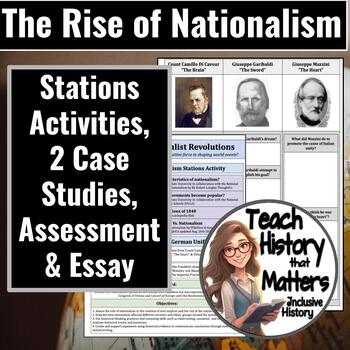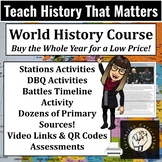Nationalism Congress Vienna Italian & German Unification Stations & Case Study
- Google Docs™

What educators are saying
Also included in
- World History Year Long Course Bundle- Everything you Need! DBQs & ActivitiesThis is an inclusive world history!Print & Go! Or edit as you see fit!Do you teach World History or AP World History? These activities, DBQs, and assessments cover all the CA World History standards for Grade 10 inPrice $101.89Original Price $155.77Save $53.88
Description
Essential Question: Was nationalism a positive force in shaping world events?
Print & Go! Everything is done for you! These are a Google documents that can edited and changed as you see fit.
Change your World history class. Throw out the textbook to instead teach with different engaging sources. This complete Nationalism Unit takes boring readings and turns them into stations activities and case studies, making them more memorable. In this lesson students will study the history of nationalism from the Congress Vienna all the way to current issues of nationalism, such as in the Israeli/Palestinian conflict. This lesson includes many rich primary source documents to really help students understand the nuances of nationalism. In the end the will write an essay answering the question:Was nationalism a positive force in shaping world events?
SWBAT:
• Define the term nationalism
• Discuss how nationalism has had positive and/or negative effects on specific nations and/or regions
• Evaluate whether nationalism in general has had a more positive or a more negative impact on the people of the world
Includes:
- Readings
- Activities
- Guided reading questions
- Graphic organizers
- Reflections
- DBQ assessment
- Essay directions, rubric, and writing help
Introduction to Nationalism Stations Activity
Station 1: What are the characteristics of nationalism?
Sources: World History for Us All A project of San Diego State University In collaboration with the National Center for History in the Schools (UCLA) & What is Nationalism by By Robert Longley ThoughtCo
Station 2: Why did nationalist movements become popular?
Source: World History for Us All A project of San Diego State University In collaboration with the National Center for History in the Schools (UCLA)
Station 3: Revolutions of 1848
Sources: Study.com & Encyclopedia Kids
Station 4: Patriotism Vs. Nationalism
Sources: Learn the difference between Patriotism and Nationalism by WikiHow & Issues and Concerns of Nationalism by Robert Longley ThoughtCo updated Aug. 26th 2021
Case Studies: Italian & German Unification Primary Source Activity Italian Primary Source Analysis Activity: Analyze quotes from Count Camillo Di Cavour “The Brain,” Giuseppe Garibaldi “The Sword” and Giuseppe Mazzini “The Heart” & Vittorio Emanuele I, King of Italy, 1861
German Primary Source Analysis Activity: Speech to the Frankfurt Assembly 1848, King of Prussia Proclamation of 1849, Otto von Bismarck: Letter to Minister von Manteuffel 1856, Field Marshal Helmuth von Moltke 1866, Proclamation of 1871 The Imperial Proclamation (Wilhelm I, King)
Standard: Discuss how nationalism spread across Europe with Napoleon but was repressed for a generation under the Congress of Vienna and Concert of Europe until the Revolutions of 1848.
Objectives: 1. Assess the role of nationalism in the creation of new empires and the rise of the nation-state. 2. Evaluate how nationalism affected different societies and ethnic groups around the world. 3. Use historical thinking practices and reasoning skills such as claim testing, causation, and sourcing to evaluate historical events and processes. 4. Create and support arguments using historical evidence to communicate conclusions through individual or shared writing.
Vocabulary:
nationalism
patriotism
Congress of Vienna
Napoleonic Wars
Revolutions of 1848
Italian Unification
German Unification
Tips for More Products:
Follow my store by simply clicking the little green star next to my name, and my new products will appear on the front page of your TPT account!
Did you know you can earn TPT credit towards future purchases?
Make sure you’re logged into your account and find your My Purchases page. For each purchase you’ve made, make sure to leave feedback (the more detailed, the better!). This feedback earns you credit towards future purchases - it’s like free TPT money! Even more important, feedback is vital, as it helps me to create new products and revise and expand on current products to make them more inclusive, engaging, and rigorous. If you have any questions regarding a TPT product you’ve purchased from me, simply leave a message and I will be sure to respond as soon as possible!



